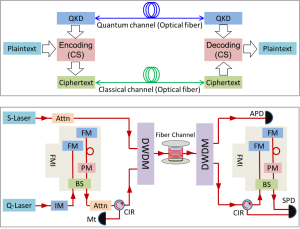Protected information and secure communication are critical for communication transmission, whether it is private, or related to enterprise operations or to national security. This has turned information and communication security technology into a primary research direction in the 21st century.

Top: Schematic diagram of experimental setup for compressed 3D image information secure communication. Bottom: The encryption key generation by the Faraday–Michelson QKD system, where Q‐Laser, quantum laser; S‐Laser, sync laser; Att, attenuator; IM, intensity modulator; FMI, Faraday–Michelson interferometer; PM, phase modulator; FM, Faraday mirror; BS, beam splitter; Mt, monitor; CIR, optical circulator; DWDM, dense wavelength division multiplexing; APD, avalanche photodiode; SPD, single photon photodiode.
So far, hybrid classical-quantum cryptographic techniques have been considered to be a powerful strategy to protect information by enhancing communication security. However, the large number of quantum keys and the relatively low-key generation rate of quantum key distribution (QKD) greatly limits the information transmission bandwidth to some hundreds of kilometers, due to losses of photons in the optical fiber and low working efficiency of single-photon detectors. So far, several post cryptography schemes that have been used to improve the bandwidth are susceptible to attack due to the large length of the message, key, and signature sizes .
To address this issue, an international team led by Shian Zhang at East China Normal University have gone beyond the current convention, developing a new hybrid classical-quantum cryptographic scheme. The new scheme combines QKD with a compressing sensing algorithm, using the quantum keys generated by QKD to encrypt and decrypt the compressed three-dimensional image information. Fewer quantum keys are therefore required in the information transmission process due to data compression, resulting in a significantly improved information transmission bandwidth of both quantum and classical channels, and facilitating the evaluation of information and communication security in real time.
According to the authors; “Since the information transmission security can be guaranteed and the information transmission bandwidth can be improved, this study can advance the hybrid classical-quantum cryptographic technique to a new level, and promote the practical applications of information and communication security.”

















